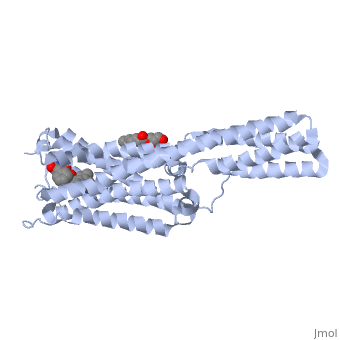4iar: Difference between revisions
No edit summary |
No edit summary |
||
| Line 1: | Line 1: | ||
==Crystal structure of the chimeric protein of 5-HT1B-BRIL in complex with ergotamine (PSI Community Target)== | ==Crystal structure of the chimeric protein of 5-HT1B-BRIL in complex with ergotamine (PSI Community Target)== | ||
<StructureSection load='4iar' size='340' side='right' caption='[[4iar]], [[Resolution|resolution]] 2.70Å' scene=''> | <StructureSection load='4iar' size='340' side='right' caption='[[4iar]], [[Resolution|resolution]] 2.70Å' scene=''> | ||
== Structural highlights == | == Structural highlights == | ||
<table><tr><td colspan='2'>[[4iar]] is a 1 chain structure with sequence from [http://en.wikipedia.org/wiki/"bacillus_coli"_migula_1895 "bacillus coli" migula 1895]. Full crystallographic information is available from [http://oca.weizmann.ac.il/oca-bin/ocashort?id=4IAR OCA]. For a <b>guided tour on the structure components</b> use [http://oca.weizmann.ac.il/oca-docs/fgij/fg.htm?mol=4IAR FirstGlance]. <br> | <table><tr><td colspan='2'>[[4iar]] is a 1 chain structure with sequence from [http://en.wikipedia.org/wiki/"bacillus_coli"_migula_1895 "bacillus coli" migula 1895]. The August 2013 RCSB PDB [http://pdb.rcsb.org/pdb/static.do?p=education_discussion/molecule_of_the_month/index.html Molecule of the Month] feature on ''Serotonin Receptor'' by David Goodsell is [http://dx.doi.org/10.2210/rcsb_pdb/mom_2013_8 10.2210/rcsb_pdb/mom_2013_8]. Full crystallographic information is available from [http://oca.weizmann.ac.il/oca-bin/ocashort?id=4IAR OCA]. For a <b>guided tour on the structure components</b> use [http://oca.weizmann.ac.il/oca-docs/fgij/fg.htm?mol=4IAR FirstGlance]. <br> | ||
</td></tr><tr id='ligand'><td class="sblockLbl"><b>[[Ligand|Ligands:]]</b></td><td class="sblockDat"><scene name='pdbligand=ERM:ERGOTAMINE'>ERM</scene>, <scene name='pdbligand=OLB:(2S)-2,3-DIHYDROXYPROPYL+(9Z)-OCTADEC-9-ENOATE'>OLB</scene></td></tr> | </td></tr><tr id='ligand'><td class="sblockLbl"><b>[[Ligand|Ligands:]]</b></td><td class="sblockDat"><scene name='pdbligand=ERM:ERGOTAMINE'>ERM</scene>, <scene name='pdbligand=OLB:(2S)-2,3-DIHYDROXYPROPYL+(9Z)-OCTADEC-9-ENOATE'>OLB</scene></td></tr> | ||
<tr id='related'><td class="sblockLbl"><b>[[Related_structure|Related:]]</b></td><td class="sblockDat">[[4iaq|4iaq]]</td></tr> | <tr id='related'><td class="sblockLbl"><b>[[Related_structure|Related:]]</b></td><td class="sblockDat">[[4iaq|4iaq]]</td></tr> | ||
<tr id='gene'><td class="sblockLbl"><b>[[Gene|Gene:]]</b></td><td class="sblockDat">5HT1B_HUMAN, HTR1B, HTR1DB, cybC ([http://www.ncbi.nlm.nih.gov/Taxonomy/Browser/wwwtax.cgi?mode=Info&srchmode=5&id=562 "Bacillus coli" Migula 1895])</td></tr> | <tr id='gene'><td class="sblockLbl"><b>[[Gene|Gene:]]</b></td><td class="sblockDat">5HT1B_HUMAN, HTR1B, HTR1DB, cybC ([http://www.ncbi.nlm.nih.gov/Taxonomy/Browser/wwwtax.cgi?mode=Info&srchmode=5&id=562 "Bacillus coli" Migula 1895])</td></tr> | ||
<tr id='resources'><td class="sblockLbl"><b>Resources:</b></td><td class="sblockDat"><span class='plainlinks'>[http://oca.weizmann.ac.il/oca-docs/fgij/fg.htm?mol=4iar FirstGlance], [http://oca.weizmann.ac.il/oca-bin/ocaids?id=4iar OCA], [http://www.rcsb.org/pdb/explore.do?structureId=4iar RCSB], [http://www.ebi.ac.uk/pdbsum/4iar PDBsum]</span></td></tr> | <tr id='resources'><td class="sblockLbl"><b>Resources:</b></td><td class="sblockDat"><span class='plainlinks'>[http://oca.weizmann.ac.il/oca-docs/fgij/fg.htm?mol=4iar FirstGlance], [http://oca.weizmann.ac.il/oca-bin/ocaids?id=4iar OCA], [http://pdbe.org/4iar PDBe], [http://www.rcsb.org/pdb/explore.do?structureId=4iar RCSB], [http://www.ebi.ac.uk/pdbsum/4iar PDBsum], [http://prosat.h-its.org/prosat/prosatexe?pdbcode=4iar ProSAT]</span></td></tr> | ||
</table> | </table> | ||
== Function == | == Function == | ||
| Line 18: | Line 19: | ||
From MEDLINE®/PubMed®, a database of the U.S. National Library of Medicine.<br> | From MEDLINE®/PubMed®, a database of the U.S. National Library of Medicine.<br> | ||
</div> | </div> | ||
<div class="pdbe-citations 4iar" style="background-color:#fffaf0;"></div> | |||
==See Also== | |||
*[[5-hydroxytryptamine receptor|5-hydroxytryptamine receptor]] | |||
== References == | == References == | ||
<references/> | <references/> | ||
| Line 23: | Line 28: | ||
</StructureSection> | </StructureSection> | ||
[[Category: Bacillus coli migula 1895]] | [[Category: Bacillus coli migula 1895]] | ||
[[Category: RCSB PDB Molecule of the Month]] | |||
[[Category: Serotonin Receptor]] | |||
[[Category: Bai, F]] | [[Category: Bai, F]] | ||
[[Category: Cherezov, V]] | [[Category: Cherezov, V]] | ||
Revision as of 20:47, 4 August 2016
Crystal structure of the chimeric protein of 5-HT1B-BRIL in complex with ergotamine (PSI Community Target)Crystal structure of the chimeric protein of 5-HT1B-BRIL in complex with ergotamine (PSI Community Target)
Structural highlights
Function[5HT1B_HUMAN] This is one of the several different receptors for 5-hydroxytryptamine (serotonin), a biogenic hormone that functions as a neurotransmitter, a hormone, and a mitogen. The activity of this receptor is mediated by G proteins that inhibit adenylate cyclase activity. Publication Abstract from PubMedSerotonin or 5-hydroxytryptamine (5-HT) regulates a wide spectrum of human physiology through the 5-HT receptor family. We report the crystal structures of the human 5-HT1B G protein-coupled receptor bound to the agonist antimigraine medications ergotamine and dihydroergotamine. The structures reveal similar binding modes for these ligands, which occupy the orthosteric pocket and an extended binding pocket close to the extracellular loops. The orthosteric pocket is formed by residues conserved in the 5-HT receptor family, clarifying the family-wide agonist activity of 5-HT. Compared with the accompanying structure of the 5-HT2B receptor, the 5-HT1B receptor displays a 3-angstrom outward shift at the extracellular end of helix V, resulting in a more open extended pocket that explains subtype selectivity. Together with docking and mutagenesis studies, these structures provide a comprehensive structural basis for understanding receptor-ligand interactions and designing subtype-selective serotonergic drugs. Structural Basis for Molecular Recognition at Serotonin Receptors.,Wang C, Jiang Y, Ma J, Wu H, Wacker D, Katritch V, Han GW, Liu W, Huang XP, Vardy E, McCorvy JD, Gao X, Zhou EX, Melcher K, Zhang C, Bai F, Yang H, Yang L, Jiang H, Roth BL, Cherezov V, Stevens RC, Xu HE Science. 2013 Mar 21. PMID:23519210[1] From MEDLINE®/PubMed®, a database of the U.S. National Library of Medicine. See AlsoReferences
|
| ||||||||||||||||||||
Proteopedia Page Contributors and Editors (what is this?)Proteopedia Page Contributors and Editors (what is this?)
OCA- Bacillus coli migula 1895
- RCSB PDB Molecule of the Month
- Serotonin Receptor
- Bai, F
- Cherezov, V
- GPCR, GPCR Network
- Gao, X
- Han, G W
- Huang, X
- Jiang, H
- Jiang, Y
- Katritch, V
- Liu, W
- Ma, J
- McCorvy, J D
- Melcher, K
- Roth, B L
- Stevens, R C
- Vardy, E
- Wacker, D
- Wang, C
- Wu, H
- Xu, H E
- Yang, H
- Yang, L
- Zhang, C
- Zhou, E X
- Electron transport
- Ergotamine
- Gpcr
- Gpcr dock
- Gpcr network
- Membrane protein
- Novel protein engineering
- Psi-biology
- Signaling protein
- Structural genomic
